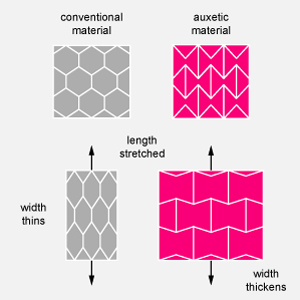Unconventional Materials - Auxetic FoamsRachel Enright, 15 March 2017Auxetic foams are defying what we thought we knew about elastic materials. Product designers here at Bayly Group are always excited about new materials and new technologies. When we came across this one, we just had to share it! Most materials become thinner through the middle when we stretch them. We know this from experience as well as education. In materials science, we call the ratio of stretching to thinning the Poisson's Ratio (PR). In conventional materials, this is a positive number: e.g. The PR for steels is about 0.3, while the PR for rubbers tends to be around 0.5. Auxetic foams are materials which have a negative Poisson’s Ratio. This means they get thicker, expanding and increasing in volume when we stretch them. This goes against everything we were taught. It also opens a world of possibilities for exciting new applications. The unique internal structure of auxetic foams causes this unusual behaviour. You can see the difference between conventional materials and auxetic materials in the image to the right. Conventional materials' hexagonal structure gets squashed when you stretch the material. Auxetic materials' 'interlocking hourglass' structures expand when you stretch it. Five Potential Benefits1. Low density 2. Effective volume increase under tension 3. High energy absorption (both impact and acoustic) 4. High fluid absorption 5. Porous and Breathable Existing ApplicationsFootwear soles which expand during walking or running allow increased flexibility (developed by Grima and Evans). GORE-TEX is a sandwich of different materials with an auxetic layer at its centre. This comes in the form of expanded polytetrafluoroethylene, or E-PTFE (aka Teflon). It prevents the ingress of large, liquid particles and allows vapour to pass through. This creates breathable, waterproof materials. Filters are not always perfectly stationary and perfectly installed. The minor stretching and warping they experience closes the pores of regular materials, drastically reducing performance. When auxetic foams marginally increase their pore size in response to stretching, performance, the filters maintain high performance in diverse conditions. What's next?This material development is at the forefront of material science. As a result, we are just at the beginning of discovering its potential applications. This is an exciting time and an exciting space to be watching! What potential applications can you think of? If you are looking for designers to develop your next product or would like more information on developing a new product, contact us here in Melbourne on +61 3 9413 9000 or send us an email at This email address is being protected from spambots. You need JavaScript enabled to view it. Don't miss out. Sign up for our newsletter now!
For further explanation of auxetic materials, check out the video below |
|
 GORE-TEX fabric is breathable and waterproof Image: fr:Wart Dark and User:Solipsist - based on fr:Image:Goretex schéma.gif, CC BY-SA 3.0, Link Footwear sole using Auxetic foam Image: Keenan Crane (Own work) [CC0], via Wikimedia Commons Header image: WikiHow
|
+61 3 9413 9000



